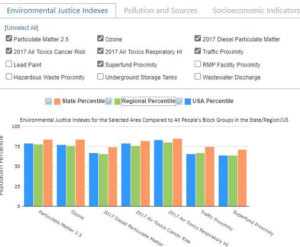“That smell … it makes you want to vomit”:
Uniontown, Alabama’s Fight Against Pollution (2000 – 2022)
Jozy Bentley
Site Description:
Uniontown, Alabama is a small (predominantly, 90.6%) black city that sits in Perry County. The people of this community have been suffering from a differential burden of air, water, and soil contamination due to two distinct pollution sources: The Arrowhead Landfill and The Southeastern Cheese Corporation. Both companies have been exposing people within the community to hazardous chemicals such as diesel exhaust constituents (e.g., particulate matter (PM), black carbon, and volatile organic compounds (VOCs)) and coal fly ash containing multiple heavy toxic metals such as arsenic, mercury, and cadmium since the early 2000s. Researchers have labeled Uniontown as one of the most horrific yet notable examples of environmental racism within the United States (U.S.) because they don’t have just one yet two polluting facilities. Researching the idea that the governors of Uniontown are not doing enough to help prevent exposure to life-threatening harming residents, animals, and wildlife The provided research will describe, explain, and suggest the long-term and short-term consequences of the pollution to humans and the ecosystem’s health. By explaining how the found information relates to environmental inequalities and generational pollution without change.
The sands of time have rendered fear
Blue skies on high no longer clear
Stars were bright whence they came
Now dimmed, obscured, pollution’s haze
Crystal clear our waters gleamed
Fish abundant, rivers streamed
Ocean floors sandy white
Now littered, brown, pollution’s plight
Trees towered high above
Trunks baring professed love
Birds chirping from sites unseen
Gone, paper joined pollution’s team
One can’t blame pollution alone
As they say, you reap what you’ve sown
So let us plant a better seed
Tear out old roots, cultivate, weed
Protect what has been given for free
Our waters, skies, wildlife, and trees
For once they’re gone, don’t you say
Consider yourself warned of that fatal day[ii]
Introduction
The people of Uniontown, Alabama (Al) did not have the chance to head the warning signs of their fatal pollutant days. For activist and protestors, the fight against pollution come in different shapes and sizes. Even though environmental pollution is a global issue, we cannot turn our heads away from the commonality that polluted cities and countries have in common, race and economics. Therefore, by using poetry and its unique ability to expressively communicate with an audience more effectively than a TED Talk or article. This poem allows for a personal connection and concern for environmental justice by expressing the importance of protecting our land and people.
Since the arrival of coal ash hit Uniontown, Al, there has been an ongoing fight between residents and local officials that concern their human rights. However, coal ash is not the only thing polluting this town. Uniontown, Al suffers from another source of pollution which is the overspray of sewage. Residents have argued that these two pollutant factors have been a direct violation of their human rights. For about a decade, the fight for an updated sewage system has been a rocky one. Town officials were given over $31 million dollars in grants to help aid in the upgrade of the town’s sewage facility. However, residents did not agree with the idea of building a wastewater treatment facility in a nearby town because it would prevent people from obtaining work within their city and the idea of sending pollution to another town just was not fair.[iii]
Then, when the coal ash showed up, residents fought for the EPA to not approve the move of the toxic ash. This became another battle lost. The EPA approved for a chemical toxin to be transported to this town which would be said was the cause of more health issues residents were already facing. This makes me ask, are the local politicians responsible for the ongoing pollution in Uniontown, Alabama? Has the town received any more outside funding to fix the economical pollution, if so, where did it go? How is the town fighting back? Just simply, what is going on?
Historiography
Uniontown, Alabama is a small town that was settled in 1818 and as of 2020, there is an estimated population of 2,107 residents. 90.85% of Uniontown’s population consists of Black or African Americans and non-African Americans. Only 9.15% of the town is white. Uniontown is also a part of the Black Belt region of Alabama which was named after the black topsoil.[iv] When the industrial revolution was on the up and up, this small town thrived from the local cotton gins, warehouses, and cotton mills. With these changes came great environmental responsibilities. Fast forward to 2007, the city allowed a company by the name of Arrowhead Landfill to open a location in Perry County. A county that has been struggling with the pollution of outdated sewage systems had to now worry about a landfill. This same landfill will be what connects Uniontown’s environmental issues to Tennessee.
In Roan County, Tennessee there is a fossil plant that spilled about 525 gallons of wet coal ash and this coal ash spill flooded nearly 3,000 acres of nearby land which destroyed about 12 homes and wildlife such as fish in a nearby river. It was later found that the nearby water was the leading cause of birth defects and health problems among workers and residents.[v] In 2010, Alabama’s Department of Environmental Management approved the transportation of the very coal ash, that was causing health problems for Roan County residents, to be transported from Tennessee Valley to Perry County of Uniontown, Alabama. This chemical ash was said to be the cause of illnesses such as brain cancer, lung cancer, leukemia, and other serious injuries to those parts of the Tennessee Emory River clean-up.[vi] How can something life-threatening be cleared for transportation? How was this ash considered to no longer be hazardous based on location? Race and class can easily explain the economical difference in protection between the two counties and states.[vii]
When thinking about global warming and environmental pollution we often find correlations between the two through politics and race. This paper will use primary and secondary sources to identify and explain the aspects concerning the environmental pollution taking place in Uniontown, Alabama as a direct result of political and racial contributing factors. Being that pollution is something that occurs globally, I hope that the provided information will encourage others to at least understand how pollution could be harmful to not only our environment but humans and animals as well.
From an economical focal point, the relationship between politics, race, and pollution has a huge impact on the people of the environment long term. The provided research will describe, explain, and suggest the long-term and short-term consequences of the pollution to humans and the ecosystem’s health. By explaining how the found information relates to environmental inequalities and generational pollution without change.
For Uniontown residents, the cause and effect of pollution is an ongoing battle between them, the EPA, and city officials. Starting with the coal ash and ending with their poor sewage installation, they have been the continuous spot for pollution for over a decade now. Hosting over 173 landfills throughout the state.
Scholarly Work
If the pollution is so bad, why are there not more scholars writing about this? Why is it that majority of Uniontown’s pollution problems only exist in articles? A Black Belt Riverkeeper by the name of Nelson Brook stated in an article that, “You take a poor rural area, take advantage of the people and turn their farming land into a dumping ground so a few people can make a profit”[ix] Scholars have taken a racial approach when discussing the pollution of communities such as Uniontown.[x] Connecting pollution to the violation of civil rights and poverty, one may see why Alabama alone is the perfect dumping ground for other states’ waste as well.
“That smell… it makes you want to vomit” is a direct quote from a Uniontown resident who just so happens to be the president of the Black Belt Citizens for Health & Justice[xi], Esther Calhoun. Calhoun is a very known activist for her community and lives nears the Arrowhead landfill. Not enough scholars are discussing places like Uniontown. We can find work on environmental issues and the racial discrimination that takes place when referring to pollution but only about big cities and very little about places like Uniontown, Alabama.
Sewage Problem
One of the biggest sources of pollution in Uniontown is their failed sewage system. Back in 1997, the Southeastern (SE) Cheese manufacturing and processing plant was established in Uniontown, AL. In 2002, this cheese plant was cleared to discharge its waste and runoff water into a nearby creek and Uniontown lagoon. Dumping enormous amounts of wastewater, these nearby water sources quickly became polluted and overfilled.[xii] Uniontown Lagoon not only was being contaminated by the SE Cheese plant, but it was already housing the wastewater from Uniontown residents and businesses. By 2002, a storage pond was developed to hold more wastewater that would spray out the contaminated water through several sprinklers onto the surrounding ground area. This system was an attempt to correct the overflow Lagoon situation but instead, the spraying of gallons of aerosolized wastewater was contaminating not only the surrounding areas but the air as well which resulted in a failed system.
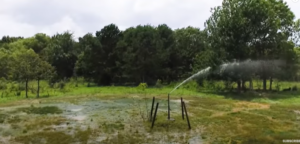
Above we can see a visual of how the overspray process works and its surrounding area. The ground is soaked in the contaminated water and the earth underneath it dies. We see no birds in the sky or animals on the ground.
These open spray systems are the main subjects when looking at the Clean Water Act. This system is alarming because this water leaks into water supplies for nearby animal farms and residents. Can you imagen your animals drinking this water and you later on eating that very animal? Or how about turning on your kitchen sink and you see brownish water or your waste smells funny? How about being afraid to consume your own homegrown food because of the fear of contamination? In most cases, this is what this community faces daily. Some residents are afraid to eat their homegrown fruits and vegetables due to the constant chemical exposure the soil and air receive.
However, that’s not the only concern residents have. For locals, the nearby cemetery is just as important and is in just as much danger as them. Generations of ancestors are at high risk of being destroyed due to this sewage overspray.
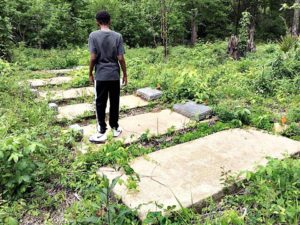
Historic African American New Hope cemetery, sacred space threatened by for-profit coal ash landfill in Uniontown, Alabama.
Here we have a young man who seems to be looking for a headstone of a loved one. This graveyard is one of the cemeteries being affected by the pollution from sewage overflow and zoning of the Arrowhead Landfill. The city promised citizens that they would protect their cemeteries, which had been there since the settlement of Uniontown. However, as we can see in this image, the graves are surrounded by weeds, plants, and trees. The ground looks soggy which could explain why the young man is walking on the slabs of concrete and not the field of grass. The smell of the air reminded him of his ancestors before him. Plots covered by weeds and overgrown greenery show the lack of care that this sacred space is given.
This cemetery is located adjacent to the landfill. This one cemetery holds the ancestry of the town. Sharecroppers, plantation workers, and slaves have a resetting place here. The companies promised to protect the cemetery from harm’s way, but residents had to take action into their own hands. Why are there no laws set into place to protect these sacred lands?[xiii] These lands have been physically altered due to the years of pollution they had to bear and still deal with. Headstones have shifted and others are broken, the ground is typically soft and oftentimes muddy, and nature is starting to cover the land to where no one can be found. How would you feel if you could not find your loved one’s grave?
Throughout history, industries have contributed to water and air pollution the most if not, alone. For Uniontown residents, the pollution of water is one of their biggest issues compared to their air pollution. Being that these systems are failing and starting to runoff into nearby streams and creeks, we must look at the data. See, when it rains this issue becomes even bigger because nearby farms and houses become flooded with sewage. Destroying crops, plants, and water supply in the process.
SE Cheese plants have been a huge contributor factor to the contamination of the plant. Having witnesses comment that they have seen workers dumping green like sludge into streams of water[xv] explains how the data levels are so high. The enforcement of the Clean Water Act is to ensure sanitary water to protect human health and maintain a clean environment.
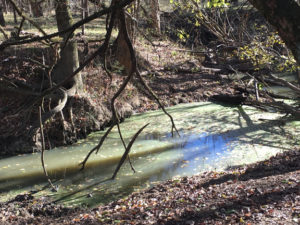
Freetown Creek was fouled by sewage overflows on November 20, 2016. Photo by Kimberly Brothers.
However, as we can see in the above image that is not the case for this suffering town and its streams of water. We see water that should be clear running through an area of forest land. The creek is of green sluggish color. Little to nothing can survive in this sort of water. Light trying to seep through the empty spaces to give life to the land. Branches die by dangling from the tree in an attempt to hold on to life. No animals visible or people. The foreground is full of darkness with a little bit of life in the far background that seems to give a little hope for nature. An area where flowers can semi-grow, and grass still exists as green. The water seems to be draining all the life out of the area it runs through. Like cancer to nature. Spreading throughout the forest, unintentionally killing life around it.
In 2015, Citizens of Uniontown submitted developmental plans to the court that would be an alternative to solving their wastewater problem. In November 2018, USDA announced a $23.4 million grant to address Uniontown’s wastewater treatment system. This grant would cover approximately 75% of the total estimated $31 million cost of the upgrades.[xvi] However, even by being granted the funds to fix this issue, residents still are fighting for things to be done in favor of the town and not somewhere else. The plan consists of a wastewater treatment facility in a nearby town with a 20-mile pipe system that would have wastewater travel from Uniontown to this new facility.
“The funding was put here for Uniontown. It was meant for Uniontown’s citizens, and I feel that the citizens are not getting a good shake out of the deal. Uniontown itself will prosper better with a treatment facility built in the town,” Jones said.[xvii] Jones and other members of the Black Belt organization believe that this new plan is only to benefit the industries within the city. In other words, the BIG BUSINESS.
Air pollution
As seen in the pollution map of Uniontown, a pollutant in the air is just as important and affected as the water. The company that contributes the most to the air quality in Uniontown is the Arrowhead landfill. Since the dumping of coal ash was made residents have been nonstop complaining about awful smells and sky visibility.
“It suffocates me to look at it,”- Esther Calhoun[xix] said in an interview. Residents complain that the awful smells nauseate them and the fear of getting sick is something they all have in common. They also tell stories about how unpleasant it is to look at.
Coal ash contains heavy metals like mercury, lead, and arsenic.[xx] These chemicals do not only pollute the lungs of humans, but it affects all living things breathing and not breathing. These toxins are absorbed through condensation and smoke that comes from machines. According to The EJSCREEN website, we can see that the pollutants within the air are high and so are other contributing factors.
Because of the constant exposure to air pollution and clay-like grounds from fallen wet ash; the elderly are at higher risk of respiratory problems and children and asthma. Having clean air to breathe in is essential to everyone’s health. The people of Uniontown are developing illness and are convinced that the constant exposure to coal ash is the cause of it. Coal ash contains over 14 different chemicals[xxi] and was deemed hazardous and radioactive before transportation.
Rev. James Murdock is one of the original members of an environmental group called the Concerned Citizen of Perry County which is one of the groups that lost the court fight against the opening of the landfill.[xxii] He is also someone who is anxious about the toxins and radioactive coal ash that is now sitting in the town.
A look at their health
Uniontown’s residences are not in the best shape. Already facing racial injustices through “genetics” they really stood no chance against the pollution they are suffering. From a city database, I retrieved a summary of the present health conditions the community face.
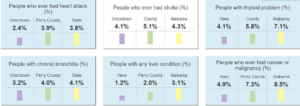
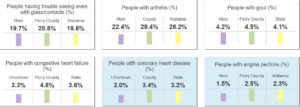
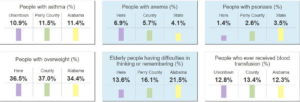
Eleven percent of Uniontown residents have ever been told by a doctor or other health professional that they had asthma.[xxiii] Some of the people who are a part of this chart have stated in videos and interviews that they were healthy their entire life up until the landfill was placed there and the dump of coal ash.[xxiv] This could be because the landfill sits approximately about 100 feet from people’s porches and front yards. These same residents are the ones who complain the most about the frequent odors, upset appetite, respiratory problems, headaches, dizziness, nausea, and vomiting. They also complain that fugitive dust from the facility has contaminated their homes, porches, vehicles, laundry, and plantings.[xxv]
What is being done?
Unfortunately, Uniontown is still battling over its win with the wastewater treatment facility. Although, a judge ordered town members to stop fighting,[xxvi] residents have not given up. They want officials to build the facility in Uniontown because it would provide jobs for plenty of residents instead of giving the work to another nearby community. As of 2020, regulations for coal ash and the improvement of the protections for public health have been presented to a court. The Environmental Protection Agency (EPA) is trying to find ways to make data such as groundwater more understandable.
The court has ruled that all facilities that are contributing to the contamination of groundwater to close. Using terms such as compacted-soil lined or clay-lined surfaces to determine the level of contamination. To correct the problem until the facility can be built, the EPA makes data more accessible and understandable for the public. They are also working on revising the groundwater monitoring system and requirements. As well as revising websites to give more relevant information.[xxvii] Over the years, progress has been slow, but progress has also been made in favor of Uniontown.
Although, the treatment facility has not yet been developed adjustments are continuously being made to accommodate the plans.
Conclusion
While climate change and the impact of pollution is something the world collectively is aware of, enough is not being done to solve the ongoing issues black and brown communities in poverty face. A lot of adjustments need to be made in order for Uniontown to have a turnaround in its environmental issues and pollution.
For starters, environmental racism needs to be acknowledged and tackled on a national/ global level in an attempt to give countries, states, cities, and communities an equal opportunity in the fight against pollution. For the United States (US) an environmental climate change organization needs to be established by the US Department of Justice. Monitorization amongst communities that suffer in silence needs to be put on the map and given a task force to help members of communities fight against this environmental injustice.
Next, the Environmental task force can prioritize and organize programs that will aid and abed in places where the act of pollution violates the civil rights of the people. It is no secret that the most hazardous materials and waste extractions are dumped in areas where the African American community is the highest.[xxviii]
Therefore, it is my conclusion that the city officials are just as responsible for the excess pollution of this town as the polluting facilities themselves. So far, the town has not received any more funding to go towards the wastewater problem. Instead, the time has been wasted in trying to convince the townspeople that building the facility elsewhere is beneficial to them and not the companies. So, these organization groups continue to fight and push for change.
Promising to protect our ancestors who came before us
But instead, they left their graves untouched and submerge in our own waste as if this is what we wanted for our future selves
A manifestation written by our United States on racial propaganda
Labeling hazardous chemicals toxic for lighter communities but not hazardous enough for our poverty-stricken families
Denied environmental equality
EPA protection
Our civil rights neglected
WE are trying
To continue thriving in these unseen circumstances
Yet something that was generationally expected
Pollution
From the air to the water
Livestock to our places of worship
Our foundation suffers
And suffered
And suffered
Til things begin to crumble, and our bathrooms become more and more like outhouses
I promise you that if I could hear the elders speak
The air would make that be often
But instead
I am here waiting
Fighting
Living
Demanding change for our future children
And grandchildren
History
Culture
For everything ALABAMA!
The Earth around us is struggling to preserve its beauty
The trains keep coming
Our sewage system transforms to fertilizer
And our living doesn’t seem to be getting much older
from continuous exposure
Of cancer-killing particles
To drink feces water.
Help me fix this
Help me fix what they couldn’t
Help me fix this community
Help me fix their narratives
Help their story to get out to the public. Help the residents rebuild their town and take back ownership of their health. Help us use poetry and art to reach the parts of the world where poetry is their best form of communication. Art, activism, and protest, just help the people of Uniontown fight back against the inhuman acts against their civil rights.
ENDNOTES
[i] Esther Calhoun, Uniontown, Alabama residents
[ii] Sylvia Stults, “Warned,” Family Friend Poems, Published October 2015https://www.familyfriendpoems.com/poem/warned
[iii] Dennis Pillion | dpillion@al.com, “Judge Orders Uniontown to Stop Fighting $31M Sewer Fix,” al, May 27, 2021, https://www.al.com/news/2021/05/judge-orders-uniontown-to-stop-fighting-31m-sewer-fix.html.
[iv] BlackFacts.com. “Black Belt (U.S. Region).” Blackfacts.com. Accessed April 25, 2022. https://blackfacts.com/fact/black-belt-u-s-region#.YmaU3C2JmO8.link.
[v] May 19, “The Lasting Damage of the Tennessee Coal Ash Spill,” Scientific American (Scientific American, May 19, 2009), https://www.scientificamerican.com/article/tennessee-coal-ash spill/?msclkid=380320d6b9d011eca0b22c73bd3fab25.
[vi] “Good News for Uniontown, Alabama after Years of Legal Battles,” Georgetown Law, accessed May 7, 2022, https://www.law.georgetown.edu/environmental-law-review/blog/uniontown-alabama-legal-battles/.
[vii] “U.S. Census Bureau Quickfacts: Roane County, Tennessee,” accessed May 7, 2022, https://www.census.gov/quickfacts/fact/table/roanecountytennessee/BZA115219.
“Census Profile: Uniontown, Al,” Census Reporter, accessed May 7, 2022, https://censusreporter.org/profiles/16000US0177904-uniontown-al/.
[viii] “Uniontown Light Pollution Map,” ClearDarkSky Light Pollution Map, accessed May 7, 2022, https://www.cleardarksky.com/lp/UntwnPAlp.html?Mn=apochromatic.
[ix] “’We’re Not a Dump’ – Poor Alabama Towns Struggle under the Stench of Toxic Landfills,” The Guardian (Guardian News and Media, April 15, 2019), https://www.theguardian.com/us-news/2019/apr/15/were-not-a-dump-poor-alabama-towns-struggle-under-the-stench-of-toxic-landfills
[x] Robert Traer, Doing Environmental Ethics (Boulder: Routledge, 2018).
[xi] “Black Belt Citizens Fighting for Health and Justice,” BBCFHJ, accessed May 7, 2022, http://blackbeltcitizens.org/.
[xii] Jon Britton, “Uniontown, Al: The Struggle against Environmental Injustice and Racism,” Liberation News, October 9, 2018https://www.liberationnews.org/uniontown-al-the-struggle-against-environmental-injustice-and-racism/.
[xiii] Engelman-Lado, Marianne, Camila Bustos, Haley Leslie-Bole, and Perry Leung. 2019. “Environmental Injustice in Uniontown, Alabama, Decades After the Civil Rights Act of 1964: It’s Time for Action.” Human Rights 44 (2): 7-11. https://login.proxy.libraries.rutgers.edu/login?qurl=https%3A%2F%2Fwww.proquest.com%2Ftrade-journals%2Fenvironmental-injustice-uniontown-alabama-decades%2Fdocview%2F2308831340%2Fse-2%3Faccountid%3D13626
[xiv] EPA (Environmental Protection Agency) accessed May 8, 2022, https://ejscreen.epa.gov/mapper/.
[xv] Engelman-Lado, Marianne, Camila Bustos, Haley Leslie-Bole, and Perry Leung. 2019. “Environmental Injustice in Uniontown, Alabama, Decades After the Civil Rights Act of 1964: It’s Time for Action.” Human Rights 44 (2): 7-11. https://login.proxy.libraries.rutgers.edu/login?qurl=https%3A%2F%2Fwww.proquest.com%2Ftrade-journals%2Fenvironmental-injustice-uniontown-alabama-decades%2Fdocview%2F2308831340%2Fse-2%3Faccountid%3D13626
[xvi] Engelman-Lado, Marianne, Camila Bustos, Haley Leslie-Bole, and Perry Leung. 2019. “Environmental Injustice in Uniontown, Alabama, Decades After the Civil Rights Act of 1964: It’s Time for Action.” Human Rights 44 (2): 7-11. https://login.proxy.libraries.rutgers.edu/login?qurl=https%3A%2F%2Fwww.proquest.com%2Ftrade-journals%2Fenvironmental-injustice-uniontown-alabama-decades%2Fdocview%2F2308831340%2Fse-2%3Faccountid%3D13626
[xvii] “Judge Orders Uniontown to Stop Fighting $31M Sewer Fix,” al, May 27, 2021, https://www.al.com/news/2021/05/judge-orders-uniontown-to-stop-fighting-31m-sewer-fix.html
[xviii] EPA (Environmental Protection Agency) accessed May 8, 2022, https://ejscreen.epa.gov/mapper/.
[xix] Keith Rushing, “Coal Ash Dump in Alabama’s Black Belt — Another Symbol of Racism’s Staying Power,” HuffPost (HuffPost, February 12, 2017), https://www.huffpost.com/entry/coal-ash-dump-in-alabamas_b_9220854.
[xx] Keith Rushing, “Coal Ash Dump in Alabama’s Black Belt — Another Symbol of Racism’s Staying Power,” HuffPost (HuffPost, February 12, 2017), https://www.huffpost.com/entry/coal-ash-dump-in-alabamas_b_9220854.
[xxi] “TVA Dumps Toxic Coal Ash in Poor Alabama Town: The Locust Fork News-Journal,” The Locust Fork News-Journal | Pioneering the Web Press Since 2005 — Freedom of the Press is NOT Free, May 14, 2018, http://blog.locustfork.net/2009/08/tva-dumps-toxic-coal-ash-in-poor-alabama-town/
[xxii] “TVA Dumps Toxic Coal Ash in Poor Alabama Town: The Locust Fork News-Journal,” The Locust Fork News-Journal | Pioneering the Web Press Since 2005 — Freedom of the Press is NOT Free, May 14, 2018, http://blog.locustfork.net/2009/08/tva-dumps-toxic-coal-ash-in-poor-alabama-town/
[xxiii] “Health and Nutrition of Uniontown, Al Residents,” Health and Nutrition of Uniontown, AL Residents: Sexual Behavior, Medical Conditions, Reproductive Health, Mental Health, Consumer Behavior, Physical Activity, Oral Health, Taste & Smell, Audiometry, Diet Behavior & Nutrition, and more, accessed May 8, 2022, https://www.city-data.com/health-nutrition/Uniontown-Alabama.html?msclkid=3d1c83decef511ec88693a184e81c66d
[xxiv] YouTube (Now This News, 2017), https://youtu.be/lNik_ZLBsWc.
[xxv] History, Captivating, and Jason Zenobia. Reconstruction Era and Gilded Age: A Captivating Guide to a Period in US History That Greatly Impacted American Civil Rights and an Era of Rapid Economic Growth. Captivating History, 2021
[xxvi] “Environmental Injustice in Alabama’s Black Belt,” Equal Justice Initiative, October 16, 2019, https://eji.org/news/alabama-black-belt-environmental-injustice/
[xxvii] EPA Press Office, EPA (Environmental Protection Agency), accessed May 8, 2022, https://www.epa.gov/newsreleases/epa-finalizes-revisions-coal-ash-closure-regulations-increases-public-access
[xxviii] Robert D. Bullard, Dumping in Dixie: Race, Class and Environmental Quality (London: Routledge, 2019)
Bibliography
19, May. “The Lasting Damage of the Tennessee Coal Ash Spill.” Scientific American. Scientific American, May 19, 2009. https://www.scientificamerican.com/article/tennessee-coal-ash-spill/?msclkid=380320d6b9d011eca0b22c73bd3fab25.
“Black Belt Citizens Fighting for Health and Justice.” BBCFHJ. Accessed May 7, 2022. http://blackbeltcitizens.org/.
BlackFacts.com. “Black Belt (U.S. Region).” Blackfacts.com. Accessed April 25, 2022. https://blackfacts.com/fact/black-belt-u-s-region#.YmaU3C2JmO8.link.
Britton, Jon. “Uniontown, Al: The Struggle against Environmental Injustice and Racism.” Liberation News, October 9, 2018. https://www.liberationnews.org/uniontown-al-the-struggle-against-environmental-injustice-and-racism/.
Britton, Jon. “Uniontown, Al: The Struggle against Environmental Injustice and Racism.” Liberation News, October 9, 2018. https://www.liberationnews.org/uniontown-al-the-struggle-against-environmental-injustice-and-racism/.
Bullard, Robert D. Dumping in Dixie: Race, Class and Environmental Quality. London: Routledge, 2019.
“Census Profile: Uniontown, Al.” Census Reporter. Accessed May 7, 2022. https://censusreporter.org/profiles/16000US0177904-uniontown-al/.
dpillion@al.com, Dennis Pillion |. “Judge Orders Uniontown to Stop Fighting $31M Sewer Fix.” al, May 27, 2021. https://www.al.com/news/2021/05/judge-orders-uniontown-to-stop-fighting-31m-sewer-fix.html.
“Environmental Injustice in Alabama’s Black Belt.” Equal Justice Initiative, October 16, 2019. https://eji.org/news/alabama-black-belt-environmental-injustice/.
EPA Press Office. EPA. Environmental Protection Agency. Accessed May 8, 2022. https://www.epa.gov/newsreleases/epa-finalizes-revisions-coal-ash-closure-regulations-increases-public-access.
EPA. Environmental Protection Agency. Accessed May 8, 2022. https://ejscreen.epa.gov/mapper/.
Family friend poems. Accessed May 2, 2022. https://www.familyfriendpoems.com/.
“Good News for Uniontown, Alabama after Years of Legal Battles.” Georgetown Law. Accessed May 7, 2022. https://www.law.georgetown.edu/environmental-law-review/blog/uniontown-alabama-legal-battles/.
“Health and Nutrition of Uniontown, Al Residents.” Health and Nutrition of Uniontown, AL Residents: Sexual Behavior, Medical Conditions, Reproductive Health, Mental Health, Consumer Behavior, Physical Activity, Oral Health, Taste & Smell, Audiometry, Diet Behavior & Nutrition, and more. Accessed May 8, 2022. https://www.city-data.com/health-nutrition/Uniontown-Alabama.html?msclkid=3d1c83decef511ec88693a184e81c66d.
History, Captivating, and Jason Zenobia. Reconstrution Era and Gilded Age: A Captivating Guide to a Period in US History That Greatly Impacted American Civil Rights and an Era of Rapid Economic Growth. Captivating History, 2021.
Rushing, Keith. “Coal Ash Dump in Alabama’s Black Belt — Another Symbol of Racism’s Staying Power.” HuffPost. HuffPost, February 12, 2017. https://www.huffpost.com/entry/coal-ash-dump-in-alabamas_b_9220854.
Traer, Robert. Doing Environmental Ethics. Boulder: Routledge, 2018.
“TVA Dumps Toxic Coal Ash in Poor Alabama Town: The Locust Fork News-Journal.” The Locust Fork News-Journal | Pioneering the Web Press Since 2005 — Freedom of the Press is NOT Free, May 14, 2018. http://blog.locustfork.net/2009/08/tva-dumps-toxic-coal-ash-in-poor-alabama-town/.
“U.S. Census Bureau Quickfacts: Roane County, Tennessee.” Accessed May 7, 2022. https://www.census.gov/quickfacts/fact/table/roanecountytennessee/BZA115219.
“Uniontown Light Pollution Map.” ClearDarkSky Light Pollution Map. Accessed May 7, 2022. https://www.cleardarksky.com/lp/UntwnPAlp.html?Mn=apochromatic.
“Uniontown Wastewater Treatment System Update as of September 2021 – Alabama.” Accessed May 2, 2022. https://adem.alabama.gov/newsEvents/reports/UniontownWWTPReport.pdf.
“’We’re Not a Dump’ – Poor Alabama Towns Struggle under the Stench of Toxic Landfills.” The Guardian. Guardian News and Media, April 15, 2019. https://www.theguardian.com/us-news/2019/apr/15/were-not-a-dump-poor-alabama-towns-struggle-under-the-stench-of-toxic-landfills.
YouTube. Now This News, 2017. https://youtu.be/lNik_ZLBsWc.
Primary Sources:
Title: How Uniontown, Alabama, Became Victim of Environmental Injustice
Location: Youtube
Description: This youtube video was created by a news reporting company called Now This News and published to their sites and youtube on the 14th of October in 2017. In this video, we are given a visual understanding of the environmental injustice that this community suffers from and the reason why our attention should be on small towns such as this. NowThis News is a social media-focused news organization that was founded in 2012 by Huffington Post.
Title: Uniontown, AL. Environmental Injustice
Location: Uniontown Al. Environmental Injustice 5-24-15 May 25, 2015
Description: This youtube video was published by a youtube by the name of Garry Morgan who is an environmentalist. He created this video with the help of the Black Belt Citizens Fighting for Health and Justice, The Alabama Rivers Alliance, and others. In this video, we get more of a one-on-one with others affected by the pollution within Uniontown. This video gives you more visual emotion and disgust. Seeing how pollution can easily seep through the cracks and poison people and animals without hesitation is scary. Focusing just on the water pollution of the area and how it travels from land to land affected those in its path.
Title: Clash in Alabama Over Landfill’s Plans to Take Tennessee Coal Ask
Location: Dewan, Shaila New York Times (1923-); Aug 30, 2009; ProQuest Historical Newspapers: The New York Times pg. 12
Description: This source is a newspaper article published about coal ash and how it traveled from Tennessee to Alabama. This article is useful because it gives a media perspective on the transportation of chemicals and the question-is of this legal? The question as to who would this move benefit and how are the people protected? Is this against their civil rights as humans?
Title: Good News for Uniontown, Alabama After Years of Legal Battles
Location: By Maxine Walters, Staff Contributor. November 15, 2019
Description: This source explains the battle between Uniontown residents and the EPA over funding to fix the current pollution problem. With the residents winning the fight to obtain the funding for correction, they did not like the idea of how the money would be used to fix it.
Title: THE IMPACT OF A COMMUNITY HEALTH ADVISOR-BASED INTERVENTION
ON SELF-REPORTED FREQUENCY OF DENTAL VISITS IN A RURAL, LOW-INCOME AFRICAN AMERICAN ALABAMA COMMUNITY
Description: This is a dissertation that reflects a health study done on the African American Community of Uniontown, Alabama. Focusing on the smiles of the people, the attempt to connect the lack of healthcare for residents can be used as an exaple of how the system is failing this community in more than one way.
Secondary Sources:
Title: Environmental Injustice in Uniontown, Alabama, Decades after the Civil Rights Act of 1964: It’s Time for Action
Location: Engelman-Lado, M., Bustos, C., Leslie-Bole, H., & Leung, P. (2019). Environmental injustice in Uniontown, Alabama, decades after the civil rights act of 1964: It’s time for action. Human Rights, 44(2), 7-11.- Time for Action
Description: This article was written to discuss the idea that the coal ash in Uniontown, Alabama was intentionally disposed of based on discrimination and basis of race.
Title: Judge orders Uniontown to stop fighting $31M sewer fix
Location: Dennis Pillion |. “Judge Orders Uniontown to Stop Fighting $31M Sewer Fix.” al, May 27, 2021.
Description: This article gives a brief insight into the founding Uniontonwn received to upgrade their sewage problem but residents never got new plumbing. The city’s mayor refuses to fix the ongoing issue. The Perry County judge ordered control over the water pollution in order to try and create new water and sewage system board.
Title: Just the start. Environmental Injustice in Alabama’s Black Belt
Location: “Environmental Injustice in Alabama’s Black Belt.” Equal Justice Initiative, October 16, 2019.
Description: This article was published on the 22nd of October 2018. It gives a little bit of background to the percentage of Black people that occupy the rural area of Perry County. Went on to explain how 49% out of the 84% of Black people live below the poverty line and seem to be directly targeted and affected by the pollution taking place in Uniontown. The writer also discusses how the residents of Uniontown filed a complaint that stated how their civil rights were being violated due to the transportation of coal ash and knowing dumping hazardous chemicals in a community will directly affect their ability to opt-in or out.
Title: Good News for Uniontown, Alabam.
Location: Good News for Uniontown, Alabama After Years of Legal Battles | Georgetown Environmental Law Review | Georgetown Law NOVEMBER 15, 2019 by Maxwell Unterhalter
Description: This article helps provide the legal battle that residents of Uniontown underwent and why. Listing sickness that occurred during/after the clean-up of coal ash, the residents of the community still had to take action and prove that what they were doing was a violation of their civil rights and toxic. This article also provides a lot of sources such as newspaper articles, EPA complaints, and census reports.
Title: Alabama Black Belt tour highlights sewage crisis; by Bryan Henry- July 30, 2018
Location: 12 WSFA
Description: This source is from a news channel that did an interview with some of the town residents. I shall use this for some of the quotes the people of Uniontown stated.
Title: EPA Rights Review Of Ash Landfill Unlikely To Spur Discrimination Finding
Location: ProQuestDocuments-2022-03-05.pdf
Description: This article is based on the EPA launch of an investigation. It helps support the injustice residents faced when dealing with toxic vs non-toxic and how the move of coal ash went against their civil rights. With residents tempting to file a lawsuit, this motion could cause the state to lose the federal government. This is interesting because for a poor community the question then arises, “well where is the funding going if not into the community”?
Image Analysis:
Click here to view the supporting video: Uniontown Is Fed Up
This video captures the land and the people of Uniontown, Alabama. This city suffers from poverty along with environmental pollution which researchers have considered to be because of race and economics. In this video, I noticed how abandoned most of the town is. Houses and businesses are boarded up and you see very few cars or traffic in the streets.

Black Belt Citizens Fighting for Health and Justice
Image courtesy Workers World
Here we have a group of residents that are a part of the Black Belt organization for the health and justice of their community. There are people of all races but the majority are of color. The faces look despise and disappear. The majority of them are older. The lady holding the sign to the right looks almost sickly. As if she is tired and worn down. Perhaps she has a breathing issue which can explain the out-of-breath look on her face. While the lady holding the sign to the left looks fed up. The woman standing behind her could possibly be her relative who may suffer from some sort of illness which could explain the angry posture she has. Shoulders raised eyes and nose squinched up. Her stance is as if she is ready to run towards the problem. In the background, we can see a little bit of why people may be tired of the way the city treats them. In the background, you have construction workers and vehicles through. The colorization of the image seems to be an illusion. I call it an illusion because it seems to be bright but at the same time I not only see a shadow hanging over them but this same illusion can be a representation of their community. In the front, everything looks prosperous. For instance, the background seems to have workers and businesses active. However, when we pull up other images of Uniontown we find more closed-up shops and run-down homes and land than anything.
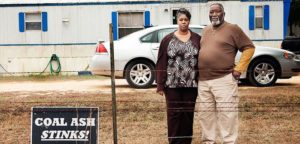
Residents of Uniontown, Alabama, in rural Perry County
This couple can be seen in one of the provided videos listed above. They are proud members of Uniontown and are currently standing on their land in front of their home. The first thing I would like for you to notice is the sign they have placed in their front yard reading “Coal Ash Stinks!” This sign implies that they can smell the burning coal ash in and outside of their home. The lack of greenery implies how the surrounding area either can’t produce healthy grass or the contaminated surroundings turned the once-green land brown. In science, brown grass usually signifies that it is dead and this has me wondering. If an unseen toxin can kill something visibly connected to the land, what is it doing to the inside of a human body? Comparing this to a can of coco-cola soda and battery acid.

Residents of Uniontown, Alabama, in rural Perry County
This image shows a current resident of Uniontown. She is sitting on the steps of her home with a face of discomfort, a posture of tiredness, and overall unhappiness. The background seems to be slightly patchy with dead grass which is possibly due to the current pollution in that area. Noticing that the plants are above ground and not in the ground could be associated with the plants not being able to survive in the surrounding soil. If she is growing her own herbs it would make sense to do it in pots to avoid the physical consumption of toxins.

Historic African-American New Hope cemetery, sacred space threatened by for-profit coal ash landfill in Uniontown, Alabama
Here we have a young man who seems to be looking for a headstone of a loved one. This graveyard is one of the cemeteries being affected by the pollution from sewage overflow and zoning of the Arrowhead Landfill. The city promised citizens that they would protect their cemeteries, which had been there since the settlement of Uniontown. However, as we can see in this image, the graves are surrounded by weeds, plants, and trees. The ground looks soggy which could explain why the young man is walking on the slabs of concrete and not the field of grass. The smell of the air reminding him of his ancestors before him. Plots covered by weeds and overgrown greenery show the lack of care that this sacred space is given.

Freetown Creek was fouled by sewage overflows on November 20, 2016. Photo by Kimberly Brothers.
We see water that should be clear running through an area of forest land. The creek is of green sluggish color. Little to nothing can survive in this sort of water. Light trying to seep through the empty spaces to give life to the land. Branches dying by dangling from the tree in an attempt to hold on to life. No animals visible or people. The foreground is full of darkness with a little bit of life in the far background that seems to give a little hope for nature. An area where flowers can semi grow and grass still exists as green. The water seems to be draining all the life out of the area it runs through. Like cancer to nature. Spreading throughout the forest, unintentionally killing life around it.
Data Analysis:
Oral Interviews:
Video Story:
This video is a collection of images I found in relation to the environmental issues the people of Uniontown, Alabama have been facing ever since a train full of hazardous coal ash came into Perry County. The Black Belt organization has been fighting for the community’s civil and environmental rights since the mid-2000s.
Welcome to good ol’ Uniontown
A town that once flourished on the back of “white” America
Soon to be“Black” community
Land they once loved so much
Quickly became forgotten by the people who deemed it for us
“Black folk”
Promising to protect our ancestors who came before us
But instead they left they graves untouched and submerge in our own waste as if this is what we wanted for our future selves
A manifestation written by our United States on racial propaganda
Labeling hazardous chemicals toxic for lighter communities but not hazardous enough for our poverty stricken families
Denied environmental equality
EPA protection
Our civil rights neglected
WE are trying
To continue thriving in these unseen circumstances
Yet something that was generationally expected
Pollution
From the air to the water
Livestock to our places of worship
Our foundation suffers
And suffered
And suffered
Til things begin to crumble and our bathrooms become more and more like outhouses
I promise you that if I could hear the elders speak
The air would make that be often
But instead
I am here waiting
Fighting
Living
Demanding change for our future children
And grandchildren
History
Culture
For everything ALABAMA!
The Earth around us is struggling to preserve its beauty
The trains keep coming
Our sewage system transforms to fertilizer
And our living don’t seem to be getting much older
from continuous exposure
Of cancer killing particles
To drinking feces water.
Help me fix this
Help me fix what they couldn’t
Help me fix this community
Help me fix their narratives

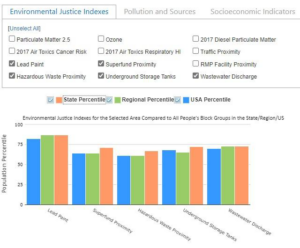 [xiv]
[xiv]